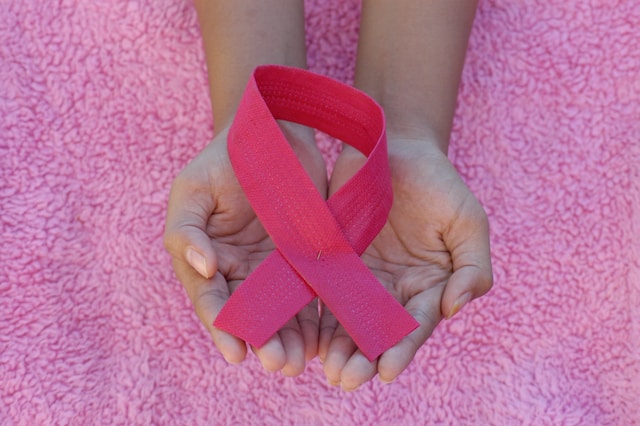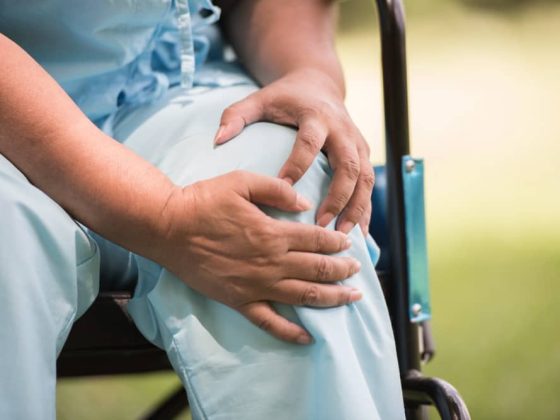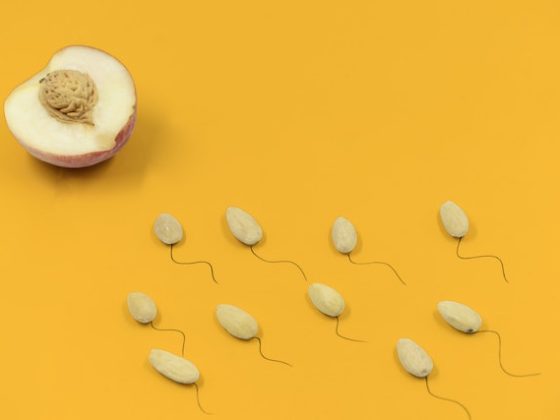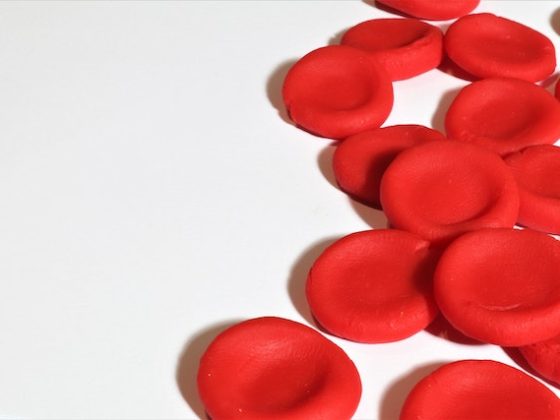Hey there! This post may contain affiliate links. As an Amazon Associate, I earn a teensy commission from qualifying purchases when you buy through these links (at no additional cost to you). For more info, please check the full disclaimer.
Breast cancer is a common and potentially life-threatening disease, affecting millions of women around the world. However, the survival rate for breast cancer depends on many factors.
Breast cancer starts when cells in the breast begin to grow abnormally and form tumors. These cells can invade nearby healthy tissue and spread to other parts of the body.
According to the World Health Organization (WHO) estimates, 1 in 8 women develop breast cancer at some point in their lifetime. Timely diagnosis and treatment are critical for extending the survival period.
What is Breast Cancer?
Breast cancer is a disease that occurs when harmful cells in the breast tissue grow uncontrollably. These abnormal cells can form a lump or mass, which can be felt during a breast exam or seen on a mammogram. Breast cancer can also cause changes in the skin or nipple, such as redness, dimpling, or discharge.
Changes in the DNA of cells cause breast cancer. These changes can happen over time, and they are not fully understood.
Doctors classify breast cancer into four stages based on the size of the tumor and whether it has spread to nearby lymph nodes or other parts of the body.
- Stage 0: The cancer is in the earliest stages and is confined to the milk ducts or lobules of the breast.
- Stage I: The cancer has grown into the surrounding tissue of the breast, but it has not spread to the lymph nodes.
- Stage II: The cancer has grown into the surrounding tissue of the breast and has spread to one or a few lymph nodes under the arm.
- Stage III: The cancer has grown into the surrounding tissue of the breast and has spread to many lymph nodes under the arm or lymph nodes in the chest.
- Stage IV: The cancer has spread to other parts of the body, such as the bones, liver, or lungs.
Survival Rate of Breast Cancer Stage 1
Stage 1 is the earliest stage of breast cancer, meaning that the cancer cells have grown beyond the ducts or lobules where they originated, but have not spread to other parts of the breast or body.
According to the American Cancer Society, the 5-year relative survival rate for women with stage 1 breast cancer is 99%. Hence, on average, women with stage 1 breast cancer are about 99% as likely as women who do not have breast cancer to live for at least 5 years after diagnosis.
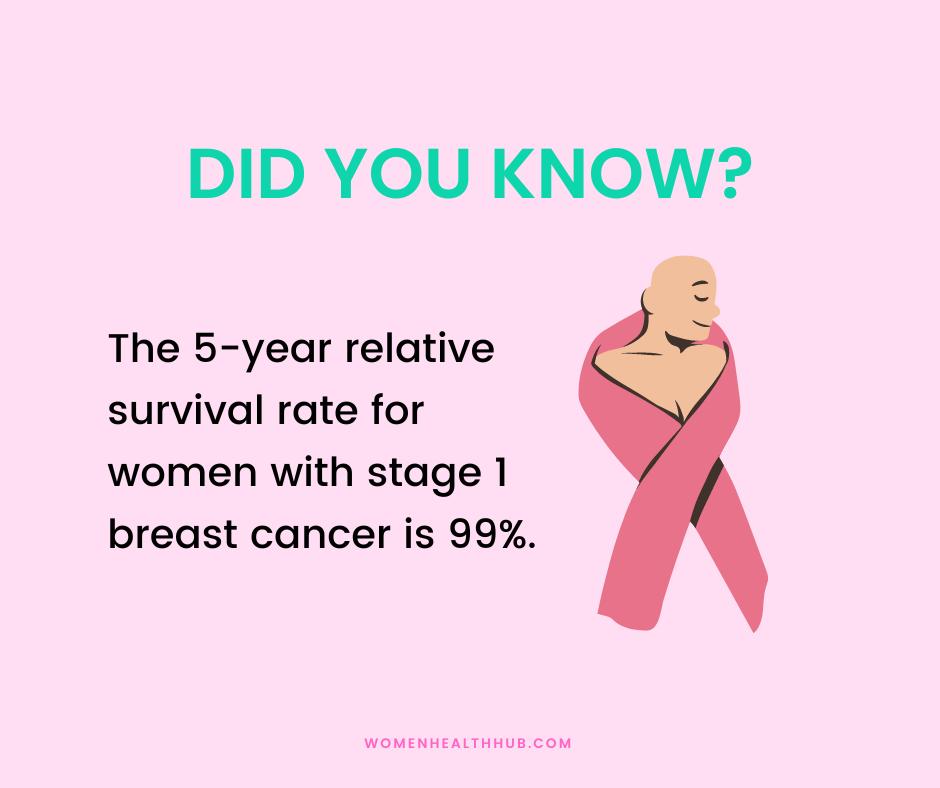
However, this number does not reflect the individual situation of each woman with stage 1 breast cancer, which can affect the prognosis.
Read More: 9 Scary Symptoms of Breast Cancer
Factors Affecting Breast Cancer Survival Rate
Various factors can influence the survival rate of breast cancer stage 1. Some are discussed below.
- Type of tumor: The type of cancerous tumor is critical for breast cancer survival rate. Hormone receptors are proteins allowing cancer cells to grow in response to estrogen and progesterone. These tumors respond better to hormone therapies than others. Women with hormone-receptive-positive tumors have better survival rates than those with triple-negative tumors.
- Age at the time of diagnosis: Younger women are more likely to have a better survival rate than women who are older at the time of diagnosis.
- Stage of cancer: The stage of cancer refers to how far the cancer has spread at the time of diagnosis. Cancers diagnosed at an early stage are more likely to be treated successfully than cancers diagnosed at a later stage.
- Tumor grade: The tumor grade is a measure of how fast the cancer cells are growing. Cancers with a higher grade are likelier to be aggressive and spread quickly.
- Spread of disease: Tumors located in a small area are easier to treat than those which have spread to multiple locations.
- Treatment: The type of treatment also affects your survival rate. Women who receive early and aggressive treatment have a better survival rate compared to those who receive poor or delayed treatments.
Some women may also have a higher or lower chance of survival based on their age, overall health and lifestyle choices, and response to treatment.
Therefore, it is important to talk to your doctor about your specific diagnosis and treatment plan, and how they may affect your outlook.
Read More: Best Foods for Breast Cancer Prevention
How to Increase Survival Rate After Breast Cancer Diagnosis
While the survival rate for stage 1 breast cancer is high, there are steps that women can take to prolong their survival rate after a breast cancer diagnosis.
- Get regular checkups: See your doctor for regular checkups, even after you have completed treatment. This allows your doctor to monitor your health and make sure that the cancer does not return.
- Follow your doctor’s recommendations: Follow your doctor’s recommendations for follow-up care. This may include taking medication, getting regular mammograms, or participating in clinical trials.
- Take care of yourself: Take care of yourself both physically and emotionally after breast cancer. This includes eating a healthy diet, exercising regularly, getting enough sleep, and managing stress.
- Join a support group: Joining a support group can be a great way to connect with other women who have been through breast cancer. You can benefit from emotional support and information about resources available to you.
- Stay positive: A positive attitude can help you cope with the challenges of breast cancer and improve your chances of survival.
Keep in mind that you are not alone. Many resources are available to help you after breast cancer. With proper care and support, you can live a long and healthy life.
Conclusion
Breast cancer is a common and potentially deadly disease, but the survival rate for stage 1 breast cancer is quite high. Women with breast cancer can take steps to prolong their survival rate by getting regular follow-up care, maintaining a healthy lifestyle, and following treatment recommendations. If you have been diagnosed with breast cancer, work closely with your doctor to develop a plan that’s right for you.
References:
- https://www.ncbi.nlm.nih.gov/pmc/articles/PMC6191354/
- https://pubmed.ncbi.nlm.nih.gov/31270761/
